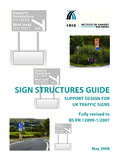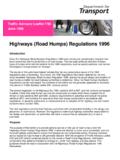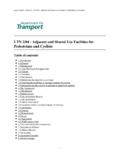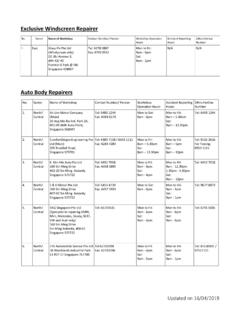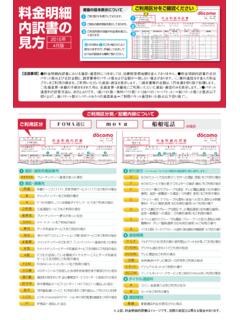Transcription of Installation Guide for MOVA - UK Roads
1 Traffic systems and signing Crown Copyright 2005 First published 1990 Printed and published by the Highways Agencytraffic systems and signing MCH 1542 Issue C September 2005 Installation Guide for MOVA MCH1542 C Installation Guide for MOVA September 2005 (This page is intentionally left blank) MCH1542 C Installation Guide for MOVA September 2005 REGISTRATION OF AMENDMENTS Amend No Page No Signature & Date of Incorporation of Amendments Amend No Page No Signature & Date of Incorporation of Amendments MCH1542 C Installation Guide for MOVA September 2005 (This page is intentionally left blank) MCH1542 C Installation Guide for MOVA Contents Spetember 2005 Contents Chapter Page No.
2 1. INTRODUCTION General .. 1 Scope ..1 Application .. 1 Development of MOVA .. 2 Glossary of Terms .. 3 2. MOVA OPERATION Improvements over System-D VA control ..4 MOVA fundamentals ..4 MOVA Control Special MOVA features for junctions with flared approaches ..11 Cycle-time control ..14 Other facilities in MOVA ..14 High-speed sites ..18 Facilities for emergency and priority vehicle control ..21 Other uses of Emergency and Priority Links ..23 Time-of-day features in MOVA.
3 24 Benefits expected from MOVA Installation ..25 3. DESIGN CONSIDERATIONS Introduction .. 26 Design 28 Site characteristics .. 29 Site Measurements .. 30 Stages and stage order .. 32 Link/Lane relationships .. 33 Pedestrian/Priority links .. 33 Traffic detector positions and functions .. 35 Drawing .. 41 Communications .. 41 MOVA Design Process For Traffic Signal Dataset preparation (MOVA-SETUP) .. 44 Example 4. IMPLEMENTATION Loop layout and specification .. 84 Duct Factory acceptance 90 Configuring the 92 Supply and fitting of MOVA 94 New Sites - fall-back 99 MCH1542 C Installation Guide for MOVA Contents Spetember 2005 Chapter Page No.
4 5. COMMISSIONING Introduction ..98 Pre-commissioning ..98 Switch to MOVA control .. 99 After commissioning ..101 Post-Commissioning 102 Completing commissioning .. 104 Commissioning problems .. 104 Error messages: Why and when they occur, what they mean and what to do .. 106 6. MAINTENANCE AND FAULT FINDING Introduction ..110 Routine attention and maintenance .. 110 Remote Access and Remote Monitoring ..111 MOVA contacts the Instation .. 111 Problems Achieving Remote Access .. 111 Dataset Maintenance - is any required?
5 112 Assessment Log and Assessment 112 Historical Flow Log ..114 Quality 114 114 7. REFERENCES General .. 115 Specifications and instructions ..115 Other 8. 116 MCH1542 C Installation Guide for MOVA Introduction September 2005 1 1. INTRODUCTION General These Guidelines supersede MCH 1542B, from the date of issue and have been up-issued to reflect the enhancements to MOVA since MCH 1542B was issued to provide users with a comprehensive and informative Guide to the MOVA method, its application and use, and in the design and implementation. Although technically superseded, the information contained in MCH 1542A still remains valid for the old Ferranti add-on units still in use (believed to be up to about 50 in number at date of issue of this Guide ).
6 MOVA is being used by many Highway Authorities who have responsibility for traffic signals, and is a requirement of Technical Directive TD 35 for new signal installations and major refurbishments on all purpose trunk Roads .. Scope This document provides technical advice on the main elements of installing MOVA, including: junction design in terms of how MOVA will work and data requirements and detector layouts, creating the MOVA data from the information and measurements collected, validation after commissioning is complete. Important to check/modify the site data to ensure optimum results. on-site commissioning to help arrive at a working system on-site, maintenance, faultfinding. Application MOVA is particularly well suited to junctions experiencing the following conditions: Sites with high traffic flow, particularly where these are seasonal or intermittent (for instance, motorway diversion routes and holiday routes).
7 Sites experiencing capacity difficulties under VA control with congestion on one or more approaches. Sites with high speed approaches and/or red compliance problems. Where additional capacity is required, for instance, to enable improved pedestrian facilities without detriment to vehicular users, to allow the introduction of dedicated right-turn facilities or to increase capacity to enable development. Where more than one junction is situated too close to be considered as isolated, there are ways in which two or more junctions can be linked by the use of MOVA control. Partially signalised roundabouts are a good example of a MOVA linking opportunity. Puffin crossings where MOVA changes in favour of pedestrians with improved efficiency over VA is able to take account of the length of time that pedestrians have been waiting.
8 Note: MOVA can only be used on a single stream (but check with the signal controller supplier), although it can be used on one of the streams at a multiple-stream junction Other streams can be linked to the stream MOVA is controlling. It can also be used where more than one junction operates on a single stream. It may be possible to reduce the control to a single stream for effective MOVA control, or to link MOVA units controlling each stream individually. MOVA can be used in conjunction with any controller with conforming to Departmental Specifications TR 2210, TR 0141, or TR 2500 (with standard UTC interface) and is available in one of the following forms: Add-on unit that connects to the controller via the standard UTC interface MCH1542 C Installation Guide for MOVA Introduction September 2005 2 Semi integral where MOVA and the Controller are separate but have a dedicated communication link Integral where the MOVA kernel software is incorporated into the Controller s operating firmware (although MOVA still effectively remains a separate functional component).
9 Development of MOVA The development of MOVA is continuously active through direct funding from the the MOVA Development Group and licence revenue income from sales of the MOVA kernel software. A number of facilities that have been added since the original site trials in 1989/90. Some of the more important ones are Bus and emergency vehicle priority control Control of linked, multiple and separately controlled pedestrian crossing movements Automatic stage sequence selections at junctions with separately signalled right turn movements Automatic double green stage sequence selection PUFFIN-style pedestrian facilities Linked MOVA for closely spaced junctions (including roundabouts) Crossings with light rail systems At the date of issue of this Guide the latest version of MOVA is M5 in which a number of new facilities have been added.
10 The more important ones include the following: A Compact version of MOVA, which will be able to accommodate urban situations where there are restrictions in siting the standard IN-detectors Improved data handling capability, making it easier for engineers to use different time of day configurations in MOVA The ability to download site configuration data from a remote instation to a MOVA M5 unit The ability to upload site configuration data from a MOVA M5 unit either locally or remotely Support for datasets with up to 10 stages, 30 lanes, 60 links, 64 detectors and 31 confirm channels for stages and phases Enhanced error handling (especially to trace problems in the MOVA program itself), including the ability to assign values to specific errors Consolidation of bug fixes and existing experimental enhancements, for instance for Puffins, where wait-light channels and kerbside detectors can be combined more flexibly The MOVA Setup program is now backwards compatible with earlier versions of MOVA and works under all recent Microsoft Windows operating systems The MOVA communications program (MOVA Comm) has been completely rewritten to include a Windows user interface, improved functionality for displaying the MOVA message log, and flexible terminal settings (any COM port, speeds up to 57 600 baud, support for serial-USB adaptors)

